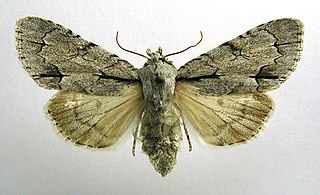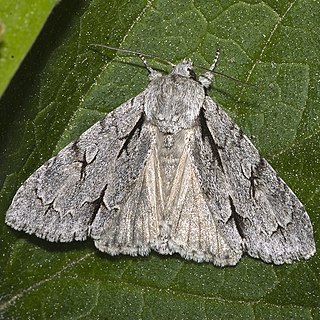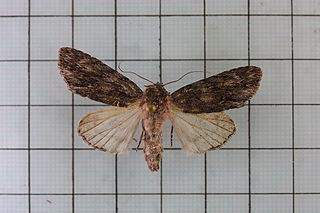
Khabarovsk is the largest city and the administrative centre of Khabarovsk Krai, Russia, located 30 kilometers (19 mi) from the China–Russia border, at the confluence of the Amur and Ussuri Rivers, about 800 kilometers (500 mi) north of Vladivostok. As of the 2021 Russian census, it had a population of 617,441. The city was the administrative center of the Far Eastern Federal District of Russia from 2002 until December 2018, when the status was given to Vladivostok. It is the largest city in the Russian Far East, having overtaken Vladivostok in 2015. It was known as Khabarovka until 1893. As is typical of the interior of the Russian Far East, Khabarovsk has an extreme climate with strong seasonal swings resulting in strong, cold winters and relatively hot and humid summers.

The dark dagger is a moth of the family Noctuidae. The species was first described by Michael Denis and Ignaz Schiffermüller in 1775. It is distributed throughout Europe, Turkey, the Near East, the European part of Russia, southern Siberia, the Ural, the Russian Far East, the Korean Peninsula, China and Japan (Hokkaido).

Acronicta is a genus of noctuid moths containing about 150 species distributed mainly in the temperate Holarctic, with some in adjacent subtropical regions. The genus was erected by Carl Linnaeus in his 1758 10th edition of Systema Naturae. Caterpillars of most Acronicta species are unmistakable, with brightly colored hairy spikes, and often feed quite visibly on common foliate trees. The hairy spikes may contain poison, which cause itchy, painful, swollen rash in humans on contact. The larva of the smeared dagger moth is unusually hairy even for this genus. Acronicta species are generally known as dagger moths, as most have one or more black dagger-shaped markings on their forewing uppersides. But some species have a conspicuous dark ring marking instead.

Acronicta alni, the alder moth, is a moth of the family Noctuidae. It is found in Europe, Turkey, the European part of Russia and the neighbouring countries, the Caucasus, the Ural, southern Siberia, Transbaikalia, the Russian Far East, China, Japan and the Korean Peninsula.

Acronicta cuspis, the large dagger, is a moth of the family Noctuidae. It is distributed through most of Europe, Northern Africa (Morocco), the European part of Russia, the Caucasus, the Russian Far East, southern Siberia, Transcaucasia, central Asia, China, Japan and the Korean Peninsula.

Catocala agitatrix is a moth of the family Erebidae. It is found in the Russian Far East, China, Korea, Japan.

Acronicta carbonaria is a moth of the family Noctuidae. It is found in Japan, the Korean Peninsula, and the Russian Far East.
Acronicta subornata is a moth of the family Noctuidae. It was described in 1889 by John Henry Leech with a type locality of Yokohama, Japan. The species is found in the Korean Peninsula and Japan (Honshu).
Acronicta leucocuspis is a moth of the family Noctuidae. It is found in the Korean Peninsula, China, Japan and the Russian Far East.
Acronicta jozana is a moth of the family Noctuidae. It is found in the Korean Peninsula, China, Japan and the Russian Far East
Acronicta adaucta is a moth of the family Noctuidae first described by William Warren in 1909. It is found in the Korean Peninsula, Japan, north-eastern China and the Russian Far East.

Acronicta hercules is a moth of the family Noctuidae. It is found in the Korean Peninsula, Japan, the Russian Far East, China, and Taiwan.

Acronicta digna is a moth of the family Noctuidae. It is found in the Korean Peninsula, Japan, the Russian Far East, China, and Taiwan.

Acronicta major is a moth of the family Noctuidae. It is found in the Korean Peninsula, China to Tibet, Japan, the Russian Far East, southern Siberia (Altai), northern India and Nepal.
Acronicta dolli, or Doll's dagger moth, is a species of moth in the family Noctuidae. It was first described by William Barnes and James Halliday McDunnough in 1818 and it is found in North America.
Acronicta atristrigatus is a species of moth in the family Noctuidae.

Acronicta spinea is a species of moth in the family Noctuidae.
Acronicta rapidan is a species of moth in the family Noctuidae. It is found in North America.
Acronicta sagittata is a moth in the family Noctuidae. The species was first described by James Halliday McDunnough in 1940. It is found in North America.
Acronicta australis is a species of moth in the family Noctuidae. It is found in North America.








